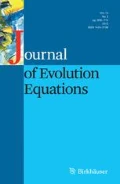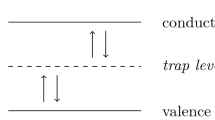Abstract
We study the drift-diffusion equation with fractional dissipation \((-\varDelta )^{\theta /2}\) arising from a model of semiconductors. First, we prove the existence and uniqueness of the small solution to the corresponding stationary problem in the whole space. Moreover, it is proved that the unique solution of non-stationary problem exists globally in time and decays exponentially, if initial data are suitably close to the stationary solution and the stationary solution is sufficiently small.
Similar content being viewed by others
References
D. Chae, J. Lee, Global well-posedness in the super-critical disspative quasi-geostrophic equations, Comm. Math. Phys., 233, 297–311 (2003)
J. Y. Chemin, Perfect incompressible fluids, New York, Oxford Press, 1988.
J. Y. Chemin, N. Lerner, Flot de champs de vecteurs non Lipschitziens et équations de Navier-Stokes J. Diff. Equ., 121, 314–328 (1995)
Q. Chen, C. Miao, Z. Zhang, New Bernstein’s inequality and the 2D dissipative quasi-geostrophic equation, Comm. Math. Phys., 271, 821–838 (2007).
P. Constantin, A. Majda, E. Tabak, Formation of strong fronts in the 2-D quasi-geostrophic thermal active scalar, Nonlinearity, 7 , 1495–1533 (1994)
P. Constantin, D. Cordoba, J. Wu, On the critical dissipative quasi-geostrophic equation, Indiana Univ. Math. J., 50, 97–107 (2001)
P. Constantin, J. Wu, Behavior of solutions of 2D quasi-geostrophic equations, SIAM J. Math. Anal., 30, 937–948 (1999)
A. Cordoba, D. Cordoba, A maximum principle applied to quasi-geostrophic equations, Comm. Math. Phys., 249, 511–528 (2004)
R. Danchin, Density-dependent incompressible vicious fluids in critical spaces, Proc. Roy. Soc. Edinburgh Sect., A 133, 1311–1334 (2003)
H. Dong, D. Li, On the 2D critical supercritical dissipative quasi-geostrophic equation in Besov space, J. Diff. Equ., 248, 2684–2702 (2010)
T. Iwabuchi, Global solutions for the critical Burgers equation in the Besov spaces and the large time behavior, J. Math. Anal. Appl., 379, 930–948 (2011)
T. Iwabuchi, Global well-posedness for Keller-Segel system in Besov type spaces, Ann. Inst. H. Poincaré Anal. Non Linéaire, 32, 687–713 (2015)
N. Ju, The maximum principle and the attractor for the dissipative 2D quasi-geostrophic equations, Comm. Math. Phys., 255, 161–181 (2005)
R. Kobayashi, M. Kurokiba and S. Kawashima, Stationary solutions to the drift-diffusion model in the whole spaces, Math. Methods Appl. Sci., 32, 640–652 (2009)
R. Kobayashi, M. Yamamoto and S. Kawashima, Asymptotic stability of stationary solutions to the drift-diffusion model in the whole space, ESAIM Control Optim. Calc. Var., 32, 1097–1121 (2012).
M. Kurokiba, T. Ogawa, Wellposedness for the drift-diffusion system in \(L^p\) arising from the semiconductor device simulation, J. Math. Anal. Appl., 342, 1052–1067 (2008)
T. Matsumoto, N. Tanaka, Lipschitz semigroup approach to drift-diffusion systems, RIMS Kokyuroku Bessatsu, B15, 147–177 (2009)
R. Metzler, J. Klafter, The random walk’s guide to anomalous diffusion: a fractional dynamics approach, Phys. Rep., 339, 1–77 (2000)
H. Miura, Dissipative quasi-geostrophic equation for large initial data in the critical Sobolev space, Comm. Math. Phys., 267, 141–157 (2006)
M.S. Mock, On equations describing steady-state carrier distributions in a semiconductor device, Comm. Pure Appl. Math., 25, 781–792 (1972)
M.S. Mock, An initial value problem from semiconductor device theory, SIAM J. Math. Anal., 5, 597–712 (1974)
M.S. Mock, Asymptotic behavior of solutions of transport equations for semiconductor devices, J. Math. Anal. Appl., 49, 215–225 (1975)
T. Ogawa, S. Shimizu, The drift-diffusion system in two-dimensional critical Hardy space, J. Funct. Anal., 255, 1107–1138 (2008)
T. Ogawa, S. Shimizu, End-point maximal regularity and its application to two-dimensional Keller-Segel system, Math. Z., 264, 601–628 (2010)
T. Ogawa, M. Yamamoto, Asymptotic behavior of solutions to drift-diffusion system with generalized dissipation, Math. Models Methods Appl. Sci., 19, 939–967 (2009)
Y. Sugiyama, M. Yamamoto, K. Kato, Local and global solvability and blow up for the drift-diffusion equation with the fractional dissipation with the critical space, J. Differential Equations, 258, 2983–3010 (2015)
H. Triebel, Theory of function spaces, Monograph in Mathematics, 78, Basel: Birkhäuser Verlag, (1978)
J. Wu, Global Solutions of the 2D Dissipative Quasi-Geostrophic Equation in Besov Spaces, SIAM J. Math. Anal., 36 , 1014–1030 (2004)
J. Wu, The two-dimensional quasi-geostrophic equation with critical or supercritical dissipation, Nonlinearity 18, 139–154 (2005)
J. Wu, Lower bounds of an integral involving fractional Laplacians and the generalized Navier-Stokes equations in Besov spaces, Comm. Math. Phys., 263, 803–831 (2005)
W. P. Ziemer, Weakly differentiable functions, Graduate Texts in Math., 120, Springer-Verlag, (1989)
Acknowledgements
The authors are grateful to the referee for his/her carefully reading. Y. Sugiyama’s work is partially supported by JSPS Grant-in-Aid for Early-Career Scientists #19K14573. M. Yamamoto’s work is partially supported by JSPS Grant-in-Aid for Early-Career Scientists #19K03560.
Author information
Authors and Affiliations
Corresponding author
Additional information
Publisher's Note
Springer Nature remains neutral with regard to jurisdictional claims in published maps and institutional affiliations.
This work was supported by JSPS KAKENHI Grant Numbers 19K14573 and 19K03560.
Proof of nonlinear estimates in the Besov space
Proof of nonlinear estimates in the Besov space
1.1 Proofs of Lemma 2
We only prove (5). (6) can be proved in completely same way as in the proof of (5). The paraproduct between f and g is defined by
where \(S_{j} f =\sum _{k \le j-1} \varDelta _k f\). We have the following Bony’s decomposition:
where \(R(f,g)=\sum _{j\in {\mathbb {Z}}} \varDelta _j f {\tilde{\varDelta }}_j g\) and \({\tilde{\varDelta }}_j =\varDelta _{j-1} + \varDelta _j + \varDelta _{j+1}\). From the quasiorthogonal property that
we see that \({\mathcal {F}}[S_{k-1} f \varDelta _k g ]\) and \({\mathcal {F}} [\varDelta _k f {\tilde{\varDelta }}_k ]\) are supported by \( 2^{k-2} \le |\xi | \le 2^{k+2}\) and \(|\xi | \le 2^{k+3}\), respectively. Hence, we have
Since \(\varDelta _j\) is bounded, we obtain
here we used \(s_1 < n/p\) in the computation of \(\sum _{k' \le k} 2^{(\frac{n}{p}-s_1) k'}\). In the case that \(s_1 =n/p\), we estimate \( \sum _{k' \le k} 2^{(\frac{n}{p}-s_1) k'} 2^{s_1 k'} \Vert \varDelta _{k'} f\Vert _{L^p}\) by \(\Vert f \Vert _{{\dot{B}}^{s_1} _{p,1}}\) in the second line of the above inequalities. Thus, we have for the first term of the right-hand side in (68)
where \(\{c_{j,q} \}_{j \in {\mathbb {Z}}}\) is a positive sequence such that \(\sum _{j \in {\mathbb {Z}}} c_{j,q} ^q \le 1\). Hence, we have
In the same way as above, we can show that
We estimate R(f, g). Since \(p \ge 2\), from (3) in Lemma 1, we obtain that
which implies that the third term of the right-hand side in (68) is estimated as follows
Taking \(l^q\)-norm with \(j \in {\mathbb {Z}}\), since \(s_1 + s_2 >0\), we have from Young’s inequality for the sum
We note that the assumption that \(s_1, s_2 \le n/2\) is not required in the proof of (69). We complete the proof of Lemma 2.
1.2 Proofs of Lemma 3
From Bony’s decomposition, the commutator is written by
If f is a solenoidal vector filed and \(g=\nabla a\), the last term \(\varDelta _j R(f,g)\) is equal to \(\varDelta _j \nabla \cdot R(f, a)\). The solenoidal property is only used in the estimate of \(\varDelta _j \nabla \cdot R(f, a)\). Here we only give an estimate of \(\varDelta _j R(f,g)\). Since \(p\ge 2\) and \(\rho -\gamma +\frac{2n}{p} >1\), applying the estimate (69) with \(s_1 =\frac{n}{p} + \rho \) and \(s_2 = \frac{n}{p}-\gamma -1\), we have that
Rights and permissions
About this article
Cite this article
Sugiyama, Y., Yamamoto, M. Asymptotic stability of stationary solutions to the drift-diffusion model with the fractional dissipation. J. Evol. Equ. 21, 1383–1417 (2021). https://doi.org/10.1007/s00028-020-00628-4
Accepted:
Published:
Issue Date:
DOI: https://doi.org/10.1007/s00028-020-00628-4



